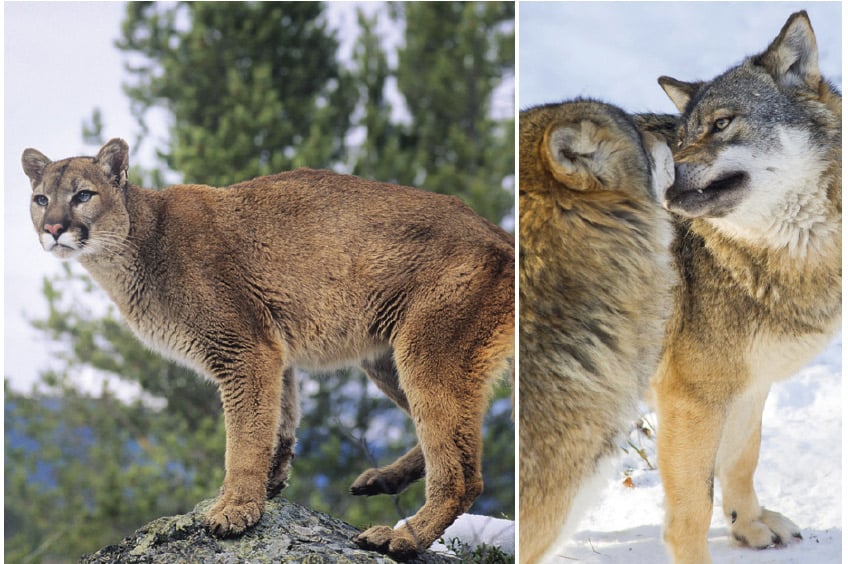Flashpoint, by Amy Anderson
Once upon a time, the red wolf inhabited the entire Southeast, and the Florida Panther was found outside of present-day Florida. But these days, large predators are largely absent from the eastern U.S. The red wolf and the Florida Panther both inhabit areas covering less than five percent of their historic ranges, in northeast North Carolina and Southwest Florida, respectively.
Our forests are undoubtedly poorer without them, but should we bring them back?
When it comes to large predators, protection and reintroduction efforts are often complicated by the politics of fear. Conservationists can toss around terms like “keystone species” as much as they like, but an animal whose lunch options might include you, or your pet, or your livestock, is not the ideal neighbor. As human populations rise and land use intensifies, our N.I.M.B.Y. (not-in-my-backyard) response to their presence leaves them with nowhere to go.
COUGAR
Only 14 fatal cougar attacks have been reported in the 20th and 21st centuries, and no known fatal wild wolf attacks have ever occurred in the contiguous U.S. In contrast, the Department of Transportation counts 300,000 reported wildlife-vehicle collisions each year and estimates the true number to be between 1 and 2 million, resulting in 14,000 injuries and at least 200 fatalities annually.
The number of attacks on humans from these apex predators is amazingly low, and maybe having a few more cougars around would mean fewer instances of fender-bender road kill.
Should the Southern Appalachians be considered potential panther territory? The eastern cougar, whose historic range included most of the Appalachians, was declared extinct by the U.S. Fish and Wildlife Service (FWS) in 2011. However, a study done in 2000 contends that there are no subspecies, just one North American puma, still represented by the populations in Florida and out west. The FWS maintains that the study was not comprehensive, and reintroducing a new subspecies into the historic range of the eastern cougar is something not provided for by the Endangered Species Act. They will not condone the establishment of new cougar populations in the Southeast until the taxonomic issue is settled.
If fortune favors the lumpers and not the splitters, then we’ll need to prepare for the cougar’s impact on adjacent lands. One reason the Florida panther has been allowed to survive in southwest Florida is the dearth of livestock operations in the Everglades. This stands in contrast to the small cattle farms and dairies in the lush lands surrounding Appalachian national forests. Popular opinion is much less likely to favor predator preservation when the local economy is built on the backs of ungulates. The Great Smoky Mountains National Park is larger than the panthers’ current habitat, but studies have not yet been done to determine whether the area could support a stable breeding population. Karen Beck-Herzog, public affairs spokesperson for Shenandoah National Park, said that although the park supports species restoration, “the land mass of Shenandoah, long and linear… surrounded largely by private land, makes the likelihood of successfully restoring a large predator in the immediate area quite low.” With perhaps 160 panthers left in the wild, habitat expansion is necessary for their long-term survival.
Laurie Macdonald, director of Florida Programs for the Defenders of Wildlife, put a positive spin on the issue: “The Florida panther is showing us that conservation action is making a huge difference for the cat’s survival and recovery. If we keep connections among big parcels of public and private lands, and if we work on coexistence practices that build people’s acceptance of this big, wild cat, the panther will be able to come back home to the American South.“
RED WOLF
Due to overzealous predator control programs and extensive interbreeding with its close relation, the coyote, the red wolf was declared functionally extinct in the wild in the 1970s. A captive breeding program began with only fourteen individuals, and the first wolf pack was reintroduced to eastern North Carolina’s Alligator River National Wildlife Refuge in 1987. The presence of red wolves has led to increases in the number of turkeys and other ground nesting birds, since the wolves prey on raccoons. Management efforts are being made to reduce coyote presence in the area, but the red wolf’s wily and invasive cousin is highly adaptive. No interbreeding appears to have occurred yet with the reintroduced population, but permanent coyote controls will likely be necessary to keep the species separate. Of the roughly 300 red wolves currently in existence, approximately two-thirds are in captivity.
Red wolves were reintroduced to the Great Smoky Mountains National Park in 1989, but a combination of factors led to the project’s failure. A number of the pups died of parvovirus. Some of the wolves, raised in captivity, showed an alarming tolerance for humans and were removed from the park population. Some of them targeted livestock just outside the park boundaries, either finding it easier than hunting deer or lacking adequate prey within the park. Park officials have no plans to attempt a second reintroduction at this time, but perhaps wolves from Alligator River’s wild-raised population would fare better as pioneers in the Smokies.
Top-level predators like cougars and wolves control the populations of deer, which protects the forest from the damage of over-browsing. Their kill leftovers provide food for scavengers and smaller predators. Their presence helps to balance ecosystems. But coexisting with predators is not risk free. Our interests and theirs do not always align. Lacking the open spaces of Montana, can we protect the investments of our Appalachian farmers from these wild animals in close quarters? And are close quarters enough room to live in if we’re willing to share?







